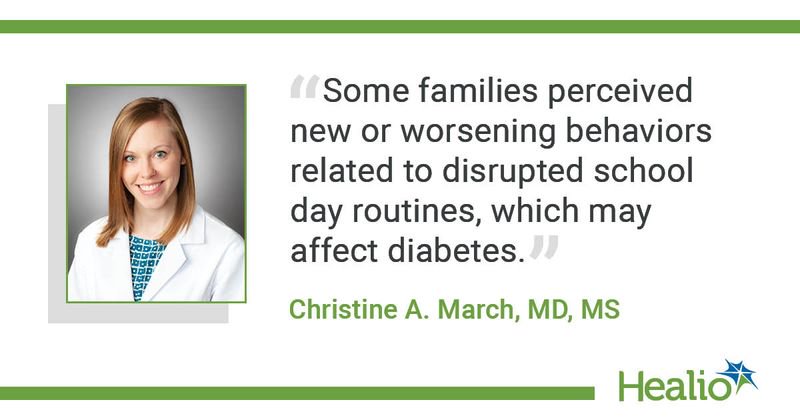Less healthy eating, physical activity for children with diabetes during virtual school
More snacking between meals, decreased physical activity and issues with sleep are among the adverse effects parents of children with type 1 diabetes reported with virtual school during the COVID-19 pandemic, according to study findings.
In data from a cross-sectional survey published in The Science of Diabetes Self-Management and Care, parents experienced numerous stressors with the switch from in-person to remote learning for their children with type 1 diabetes during COVID-19, including balancing their child’s diabetes management with work, helping their children with school work and having multiple children in school simultaneously.

“Our findings highlight some of the many stresses placed on families during the pandemic,” Christine A. March, MD, MS, assistant professor of pediatrics in the department of pediatric endocrinology at the UPMC Children’s Hospital of Pittsburgh, told Healio. “For some children and families, it can be especially challenging to maintain a normal daytime routine in virtual school, particularly if the school uses an asynchronous learning model. This lack of a routine can affect sleep, eating habits and activity, all of which may affect diabetes management in children.”
March and colleagues surveyed parents of children with type 1 diabetes receiving care at the UPMC Children’s Hospital of Pittsburgh (67 responses, children were 88% white; 52% boys; mean age, 12 years). Parents of children enrolled in grades kindergarten to 12 who attended a traditional brick-and-mortar school prior to the pandemic and transitioned to remote learning during the pandemic were asked to participate. The survey was conducted in August and September 2020. The survey questions examined diabetes management at home and the impact of remote learning on health behaviors affecting diabetes. Participants also answered questions about returning to in-person school. Information on demographics, diabetes management regimen and family-identified stressors were self-reported.
Parental stressors with shift to remote school
Before the pandemic, 51% of the respondents said their child’s diabetes care was handled by school staff, and 39% said their child handled their care independently. With remote learning, 72% of parents reported managing their child’s diabetes, with most saying they did so while also working from home.
Of the respondents, 35% said they experienced at least two stressors related to the pandemic. Having multiple children in remote learning simultaneously was reported by 53% of respondents, helping their child with school was reported by 47%, and 36% said they struggled with managing their child’s diabetes while working. Sixty-three percent of parents said their child could not continue their school day routine at home. Few participants reported any changes with glucose monitoring or insulin dosing, but 39% said their child’s snacking between meals worsened, 42% said their child was less physically active and 60% said their child had more issues with sleeping.
“In other studies, we didn’t necessarily see a big change in measures of glycemic control during the pandemic,” March said. “However, our findings demonstrated that some families perceived new or worsening behaviors related to disrupted school day routines, which may affect diabetes. Over time, these could become problematic for children’s physical and mental health. Health care providers can try to identify these issues early and work with families on establishing healthy patterns.”
Parents of adolescents aged 12 years and older were more likely to report worse healthy eating habits (P = .04), worse sleep habits (P = .04) and worse glycemic control (P = .03) than parents of children younger than 12 years. Parents experiencing at least two family-identified stressors were more likely to reported worse diabetes care (58% vs. 26%; P = .006), increased snacking (58% vs. 28%; P = .03) and worse glycemic control (41% vs. 14%; P = .04) for their children compared with those reporting no stressors or one stressor.
March said there are some limitations that may affect the generalizability of the findings, as the study population was small and reported higher socioeconomic markers.
Concerns with return to in-person schooling
Participants had several concerns about returning to school, with 45% saying they were at least moderately worried and 30% saying they would likely keep their child home. Of those who wanted to keep their child home, 60% reported concerns about the prevalence of COVID-19 in their community, 55% cited school safety plans, 40% were worried about class size and 38% said they had concerns about COVID-19 infection for people with diabetes.
At least 70% of parents stated schools should enforce social distancing, lower class sizes, implement routine COVID-19 screening and mandate masks. Nearly all parents endorsed receiving information on COVID-19 school safety from their local district, whereas 31% were comfortable getting information from news outlets, 28% from medical websites and 19% from their diabetes provider.
March said the survey data can be used by health care professionals to help parents develop strategies and reduce stress with caring for their child with diabetes during remote learning.
“With transition to virtual education at home, some families may feel like they can pay more attention to their child’s diabetes, while others may really struggle with the change in routine, particularly teens,” March said. “For those struggling with changes in routine, it may be helpful to mimic the school day as much as possible. Keeping up with regular bedtimes, scheduling physical activity, and trying to stick to a meal plan may all be simple yet effective interventions, particularly if the school only offers asynchronous learning.”
For more information:
Christine A. March, MD, MS, can be reached at christine.eklund@chp.edu.
